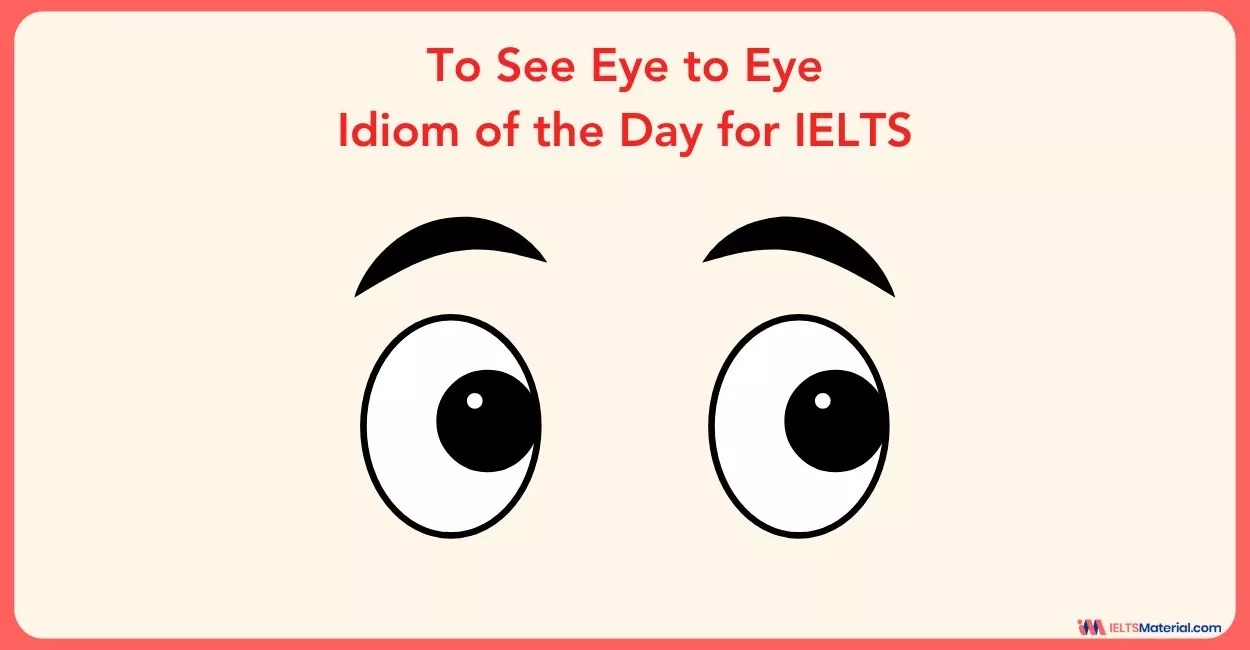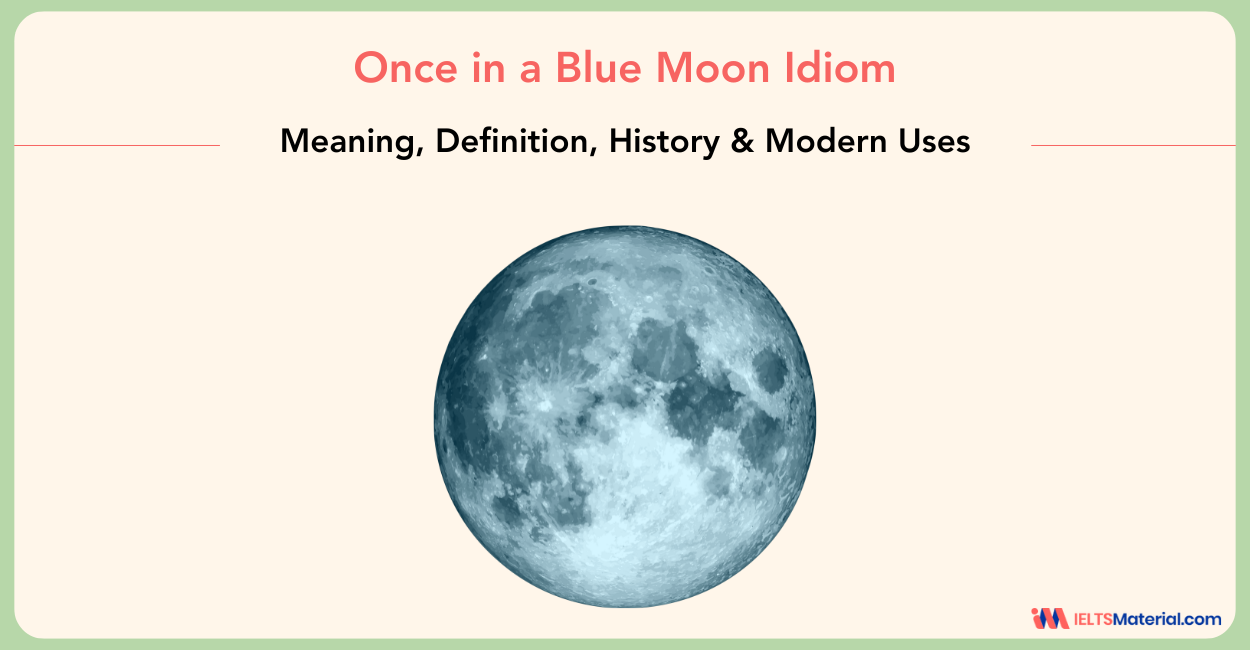To See Eye to Eye - Idiom Of The Day For IELTS
3 min read
Updated On
-
Copy link
Do you think you know what the idiom ‘To See Eye to Eye’ means? Explore its meaning, origin, and real IELTS Speaking & Writing examples. Try our quick article to boost your lexical resources!
Table of Contents
- Meaning of the ‘To See Eye to Eye’ IELTS Idiom
- Where Did the Idiom ‘To See Eye to Eye’ Come From?
- Synonyms of the ‘To See Eye to Eye’ Idiom
- Antonyms of the ‘To See Eye to Eye’ Idiom
- Common Mistakes to Avoid While Using the ‘To See Eye to Eye’ Idiom
- A Sample Scenario to Use the Idiom ‘To See Eye to Eye’

Limited-Time Offer : Access a FREE 10-Day IELTS Study Plan!
While making proper use of suitable idioms in your speech as you converse in English in an everyday setting will clearly enhance the way you convey an intended message.
One of the commonly used idioms these days is ‘To See Eye to Eye.’ This is especially used by many in both casual and professional discussions, mainly when people agree on the same idea together without any arguments. That is what makes it perfect for the IELTS exam.
In this article of ours, we will learn the meaning, origin, and usage of the ‘To See Eye to Eye’ idiom, along with examples of how to use it to your advantage when preparing for the IELTS Speaking and Writing!
Meaning of the ‘To See Eye to Eye’ IELTS Idiom
This idiom “to see eye to eye” means to a person agreeing with someone or when they try to share the same opinion or an idea. This suggests harmony and a mutual understanding between two people.
This idiom is usually used to describe personal relationships, a proper teamwork, professional space collaboration, and even in a political setting.
In the IELTS exam, this idiom can be really effective in both the Speaking or Writing tasks when they discuss agreements, problem-solving, relationships, team work or cooperation in a society.
For example:
In the IELTS Speaking Part 3 discussion about A workplace collaboration, you can say:
“In all of the successful companies, the employees and managers need to see eye to eye on a long-term goals to achieve progress.”
This idiom highlights not only an agreement, but also the mutual respect and shared understanding, as it makes it a strong choice to express unity.
Ready to improve your IELTS Writing game with our best experts? Book a FREE Demo!
Where Did the Idiom ‘To See Eye to Eye’ Come From?
This phrase originates from the Bible, mainly from the Book of Isaiah (52:8), where in it describes watchmen who see “eye to eye” as they enjoy together. In this context, it directly symbolized unity and shared vision.
Over the time, the expression came into everyday English, evolving into this idiom we use today. While the roots of it were originally religious, the modern use of it is entirely secular, appears in business, entertainment, politics, education, and everyday conversation.
Synonyms of the ‘To See Eye to Eye’ Idiom
- Agreeing with
- Being on the same page
- Sharing the same opinion
- Being of the same mind
- Having a mutual understanding
- Being in accord
- Having a consensus
- Thinking alike
Antonyms of the ‘To See Eye to Eye’ Idiom
- Disagreeing with
- Being at odds
- Being in conflict
- Differing in opinion
- Clashing
- Being at loggerheads
- Disputes
- Being in disagreement
Grab our fast-selling IELTS Vocabulary Ebook to learn a wide range of words for your IELTS Writing test!
Common Mistakes to Avoid While Using the ‘To See Eye to Eye’ Idiom
-
Using it in a literal context
The idiom does not mean literally making an eye contact. It is just about agreement.
-
Overusing it often
While it is useful, repeating it too often can sound really unnatural in IELTS responses.
-
Applying it in an inappropriate context
The idiom is perfect for opinions and ideas, not physical descriptions. For instance, do not say “She saw eye to eye with her on the bus.”
-
Using incorrect grammar
Some of the correct forms include “They saw eye to eye” or “she didn’t see eye to eye,” not “we both saw eyes to eyes.”
A Sample Scenario to Use the Idiom ‘To See Eye to Eye’
In the IELTS Speaking Part 2, if you are asked to describe a period when you worked in a group, you can say:
“When Meena was in university, she worked on a group project with five classmates. At the beginning, we didn’t see eye to eye on how to divide the work. However, after properly discussing our strengths, we then eventually agreed and managed to complete the task successfully.”
This particular example shows how this idiom can naturally talk about conflict resolution and a proper cooperation, both of which are very common IELTS topics.
Useful Links:
- Close but no Cigar Idiom: Meaning, Origin, Usage & Exercises
- Bottom of the Barrel Idiom: Meaning, Origin, Usage & Exercises
- Running on Fumes Idiom: Meaning, Origin, Usage & Exercises
- Common Idioms to Boost your IELTS Score - Topic: Starting and Stopping
- Top 11 IELTS Vocabulary Books
- How to Improve Your Vocabulary Score in IELTS Writing and Speaking?
Explore IELTS Resources

Start Preparing for IELTS: Get Your 10-Day Study Plan Today!
Recent Articles

Kasturika Samanta

Prity Mallick

Nehasri Ravishenbagam





Post your Comments